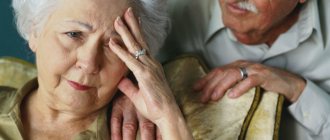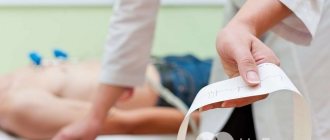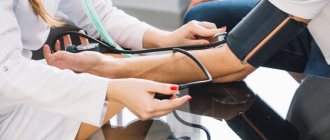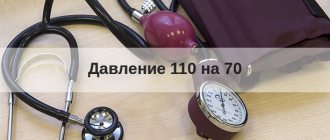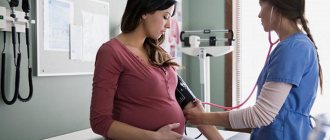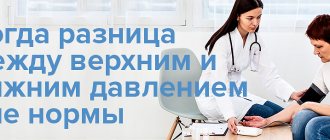A hungry person sometimes experiences a feeling of general malaise, weakness, nausea, and fatigue. After eating, for many this condition disappears.
But for some people, similar symptoms occur precisely after eating. At the same time, the blood pressure level decreases.
This phenomenon in medicine is called postprandial hypotension. But why does blood pressure drop after eating? Determining the cause of low blood pressure in a hypertensive patient or a healthy person is impossible without a diagnostic examination, including blood pressure measurements, blood and urine tests, and collection of medical history.
Clinical manifestations
Why does blood pressure drop after breakfast or any other meal? Postprandial hypotension in English means “lunchtime”. This means that blood pressure levels tend to drop after consuming foods. In patients suffering from this disease, the decrease in pressure is, on average, 20 mmHg.
The clinical manifestations of the disease are easily confused with the symptoms of ordinary hypotension. Patients experience:
- heart rhythm disturbances;
- feeling tired and drowsy;
- excessive sweating;
- dizziness and headaches;
- speech and vision disorders;
- pain in the sternum and heart;
- apathetic state characterized by lethargy;
- fainting after a meal.
Patients begin to feel unwell immediately after consuming foods or drinks. Added to the above problems are nausea, leading to vomiting, as well as black dots flashing before the eyes.
Symptoms of postprandial hypotension can occur even in patients suffering from arterial hypertension.
What foods to include in your diet to increase blood pressure
Since in postprandial hypertension the cause of a decrease in blood pressure is food intake, it is necessary to correctly formulate the diet and include in it foods that can increase blood pressure:
- Use pickles and marinades in small quantities, so that the total amount of salt does not exceed 15-20 g per day. Sodium retains water and increases blood circulation.
- Spices and herbs increase the secretion of the digestive glands and contribute to the narrowing of the vascular walls.
- The amino acids contained in nuts are beneficial for patients with postprandial hypotension.
- The menu should include vitamins C and B (eggs, liver, yeast, berries), as well as fruits that tone the body - lettuce, celery, sour apples, cabbage.
- Fatty foods increase the concentration of cholesterol in the blood, resulting in increased blood pressure.
- If your blood pressure drops sharply, you can drink a cup of coffee, strong tea, or energy drink.
Foods high in carbohydrates (baked goods, fried potatoes, pasta) help lower blood pressure. Insulin and other substances that are released when it is consumed dilate blood vessels, causing a drop in blood pressure. The development of hypotension is also provoked by a large amount of sugar and its substitutes.
Important information: At what stage of pregnancy does preeclampsia usually occur?
You need to carefully plan your diet for postprandial hypertension - abuse of fatty foods, spices, and salt can provoke other diseases. In addition, they contribute to excess weight gain, which worsens the condition of the cardiovascular system. You need to eat in small portions, avoiding hunger or overeating. After eating food, it is better not to get up from the table, but to sit quietly for 30-40 minutes. To normalize the condition, it is important to drink a lot - the volume of liquid should not be less than 1.5-2 liters per day.
Even if your blood pressure regularly drops after eating, you should not refuse food, as this can lead to a worsening of the condition. You need to have a full breakfast, lunch, and dinner, following the doctor’s recommendations for creating a diet.
Prerequisites for the disease
It is impossible to unequivocally answer the question of why blood pressure drops after eating.
There are some factors that contribute to changes in pressure:
- elderly age. Patients over 65 years of age are susceptible to the disease due to age-related changes occurring in the body;
- organic brain lesions, including Alzheimer's disease and Parkinson's disease;
- mental illnesses, including neurasthenia, psychopathy, neuroses;
- endocrine diseases.
Patients who regularly attend hemodialysis and patients with chronic kidney disease are at risk of developing this disease.
Diagnostics
Since the symptoms of postprandial hypotension are similar to arterial hypotension, it is impossible to rely only on blood pressure measurements when making a diagnosis.
Blood pressure monitoring should be carried out over several weeks, and its values should be recorded while taking medications, during specific activities and during sleep.
Specific activities include eating, physical activity, and standing. Also, to diagnose the disease, special testing is carried out to detect transient arterial hypotension. Hypotension may be a symptom of renal dysfunction, neurogenic fainting, and other diseases.
Diagnostic measures must be carried out in order to establish the cause of a drop in blood pressure in hypertensive patients or a healthy person, and to identify physiological or pathological disorders. So, if there is a sharp drop in blood pressure, the cause for a hypertensive patient may be an overdose of antihypertensive drugs.
To begin with, the doctor collects anamnesis, listening to the patient’s complaints. Then he prescribes examinations to confirm or exclude heart disease, infectious diseases, anemia, and disorders of the endocrine system.
A urine test is performed to determine sodium and potassium levels. This will reveal whether the patient suffers from adrenal insufficiency or not.
If, a couple of hours after eating, the pressure regularly decreased by at least 20 mmHg throughout the monitoring, or if the pressure remains at the same level, but the patient shows signs of a hypotonic state, then this may indicate the presence of postprandial hypotension. The doctor makes the final diagnosis after comparing pressure measurements and diagnostic test data.
Postprandial hypotension affects the body in a complex manner, which means that to eliminate the problem, you should undergo examination by specialists in various fields: cardiologist, gastroenterologist, neurologist, nephrologist, endocrinologist.
Symptoms of hypotension
The main symptom of hypotension is a decrease in blood pressure to 90/60 mm Hg. Art. or lower. Each person can measure their blood pressure independently at home using a tonometer. In addition, signs indicating arterial hypotension include the following:
- feeling of general weakness, lethargy, drowsiness;
- increased sweating;
- disturbances in heat exchange processes (cold extremities);
- increased heart rate;
- sleep disorders;
- emotional instability (periods of irritability, apathy);
- dizziness and headache (mostly dull in the frontal and temporal regions);
- aching pain in the heart;
- dyspnea.
Sometimes hypotension can manifest itself as fainting, especially in rooms where there is little fresh air. In general, people with low blood pressure react negatively to changes in air temperature, changes in air humidity, as well as to various emotional stimuli. Isolated cases of these symptoms may not indicate the presence of hypotension, but if there are several symptoms and they are constant, then you should consult a doctor.
Treatment
Treatment of the disease includes changing dietary habits and a healthy lifestyle. If necessary, the doctor prescribes drug therapy.
Since a decrease in pressure occurs after eating, the main recommendations are related to food consumption:
- spices should be consumed within reasonable limits;
- it is necessary to reduce the amount of quickly digestible carbohydrates in the diet;
- overeating should not be allowed;
- You should not fast for a long time.
If a sign is detected that a product leads to a decrease in blood pressure, it should be excluded from the menu. You need to avoid stressful situations, strengthen your immune system and include physical activity in your daily routine.
How to properly plan a diet?
There is no special diet for arterial hypotension, just as there are no restrictions on the intake of foods or methods of cooking them. But no one has canceled the rules of healthy eating when there is a decrease in blood pressure after eating. You should absolutely not get carried away with diets, including newfangled ones, such as a raw food diet and blood type diets.
Nutrition for hypotension should be healthy, without dietary restrictions, and must include:
- a large number of green vegetables;
- grains and legumes;
- high-quality fats, sea fish, eggs, chicken meat;
- dairy products from goat milk;
- various fruits;
- not roasted nuts and seeds.
Any hydrogenated fats, synthetic additives, and especially sugar substitutes for hypotension are categorically excluded. A patient suffering from low blood pressure should definitely drink plenty of fluids.
For headaches and general weakness, a quick but short-term effect is provided by strong tea and coffee, cocoa, dark chocolate.
After some time, cheerfulness will be replaced by apathy. The substances contained in these products deplete the body, returning strength for a while, and then increasing fatigue and weakness.
For hypotension, it makes sense to pay special attention to spices, especially hot ones: cayenne pepper, chili pepper. You can use cinnamon in small quantities. Soy is not recommended for low blood pressure. Symptoms of postprandial hypotension are significantly reduced by drinking 0.5 liters of warm water, about 22 degrees.
For postprandial hypotension, fasting is prohibited! Even short-term fasting can lead to secondary arterial hypotension in patients who had normal blood pressure.
Additional nutrition tips
If you experience regular changes in blood pressure after eating, you should follow a few simple rules that are also relevant for healthy people.
- Avoid overeating. You can eliminate the absorption of excessive amounts of food by eating small and often. The optimal solution is 5 meals a day in portions not exceeding 300 ml in volume.
- You shouldn't eat before bed. The last meal should be no later than 1-3 hours. Sleeping on a full stomach will be restless, and the body will need more energy to digest food, which can cause an increase in blood pressure.
- Fasting for hypertension or hypotension is excluded without consultation with the attending physician.
- The best way to prepare food is steaming, the worst way for vascular health is frying.
- It is important to maintain a drinking regime, drinking 1.5–2 liters of clean water per day. For chronic hypertensive patients, these numbers should be reduced, since a large amount of fluid can raise blood pressure.
- You should exclude carbonated drinks, fast food, unhealthy sweets, and canned food from your diet.
- The proportion of fiber-rich foods should increase.
- The main components of the plate should be vegetables, herbs, fruits, dairy products, lean meats and fish.
- If you feel that your blood pressure is rising after eating something, or your heart rate is increasing, you should measure your blood pressure and take the medications recommended by your doctor to stabilize your condition.
Advice!
Coffee, tea, and alcoholic drinks should be replaced with water, juices, fruit drinks and compotes based on vitamin-rich fruits and berries. No ads 2
Video on the topic
The main reasons for low blood pressure in humans:
If after eating your blood pressure regularly drops by at least 20 mmHg, this may be a manifestation of postprandial hypotension. The clinical picture of the disease is similar to the signs of arterial hypotension and manifests itself in general malaise, increased heart rate, drowsiness and apathy after eating, excessive sweating, chest and heart pain, speech and vision disturbances, and sometimes fainting.
If blood pressure drops after eating, the causes can only be identified through long-term blood pressure monitoring and a series of diagnostic tests. The main treatment is aimed at changing lifestyle and diet. Patients' meals should be fractional. You should avoid taking carbohydrate foods. Coffee, tea, and spices are allowed. You need to drink enough water and avoid drinks with high sugar content. Therapeutic exercises and giving up bad habits will also contribute to recovery.
The information on the MyMedNews.ru website is for reference and general information, collected from publicly available sources and cannot serve as a basis for making a decision on the use of medications in the course of treatment.
MyMedNews.ru
And we also have
Obesity causes changes in brain structure
Symptoms
Manifestations of postprandial hypotension are similar to those of other forms of the disease. The patient develops the following symptoms:
- starts to hurt and feel dizzy;
- heart rate increases;
- I feel sleepy and feel very weak;
- increased sweating occurs;
- chest pain is felt;
- visual and speech disturbances are possible.
Important information: Dropper for binge drinking: features of the procedure, action and composition
If the pressure drops too quickly, the person may faint. Such falls are dangerous in old age, as they often lead to serious injuries.

